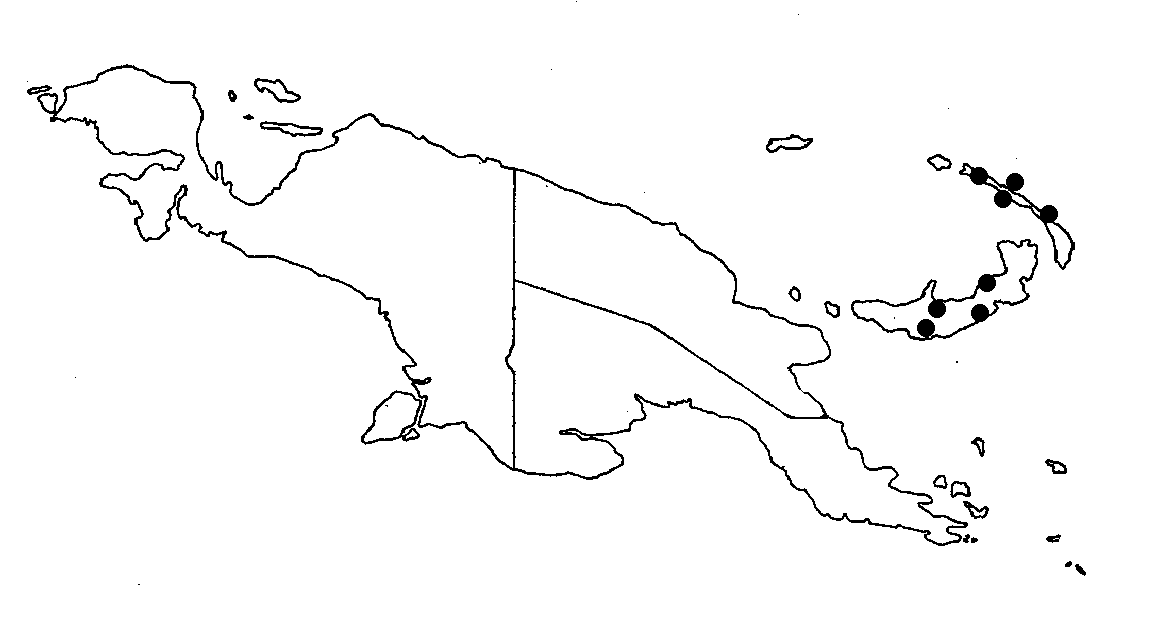
Distribution Map

Description (Barlow 1992)
Loranthus novaebritanniae (...vae-bri ...) Schumann in Schumann & Lauterbach, Fl. Deutsch. Schutzgeb. Siidsee, Nachtr. (1905) 259. - Amyema novaebritanniae (Schumann) Danser, Bull. Jard. Bot Buitenzorg III,I0 (1929) 297. - Type: Schlechter 13765 (Iecto K, see below), New Britain, near Mandres, xi.l901.
For description and additional synonymy see Barlow, Austral. J. Bot. 22 (1974) 581. Amyema novaebritanniae has few specialized characters and thus presents a relatively generalized facies for the genus. The species can be identified locally by its combination of glabrous slender parts, thin, acute, isobilateral petiolate leaves, fewrayed umbel, and distinctly pedicellate lateral flowers. The flower colour is described as red, mostly grading to yellow or green in the upper part
The species occurs in New Britain and New Ireland (fig. 10; 9
collections seen), from sea level to 1060 m elevation.
Habitat details and hosts are unknown. It is probably closely
related to A. artensis which is common in eastern New Guinea
and extends to New Caledonia and a few other Pacific islands.
Amyema artensis differs in its generally fewer-rayed umbel,
sparse inflorescence indumentum, and bifacial leaves. See note
under A. artensis.
The holotype of Loranthus novaebritanniae
(B) is no longer extant. An isotype in K has been seen and
designated lectotype of the name.
Description (Barlow 1974)
Amyema novae-brittanniae (Schum.) Dans. Bull. Jard. bot. Buitenz. 10: 297 (1929); Loranthus novae-brittanniae Schum. in Schum. & Lauterb. Nachtr. (1905) 259. Type.-New Britain, Bei Mandres, Schlechter 13765, Nov. 1901 (B, holotype, not seen, probably destroyed; K).
Loranthus ]ambosae Schulze, Notizblatt. Berl. Dahl. 13: 53 (1936); Amyema jambosae (Schulze) Dans. Bull. Jard. bot. Buitenz. 14: 91 (1936). Type-New Ireland, Ugana, 0 m alt., Peekel 1222 (B, not seen, probably destroyed).
Glabrous. Stems flattened when young, soon becoming terete. Leaves opposite; petiole 1-1.5 cm long; lamina elliptical to ovate, 4-8 by 2-4.5 cm, dull on both sides, attenuate at the base, undulate at the margin when dry, mostly acute at the apex (less frequently rounded or notched); venation pennate with only the midrib visible and raised below. Inflorescences 1-2 in the axils; peduncle slender, 5-12 mm long; rays 4-6-(7), 5-8 mm long; pedicels of the lateral flowers of the triads 2-3 mm long; bracts spreading, acute, 1-2 mm long. Calyx cylindrical, narrow, 2-3 mm long; limb erect, toothed, 07-1 mm long. Corolla in the mature bud clavate and obtuse at the apex, 14-20 mm long; petals in the open flower 5, distinctly narrow-spathulate. Anthers 0.7-1.5 mm long; free parts of the filaments c. 4 mm long. Chrornosorne Number-n = 9 (Barlow and Wiens 1971). Voucher: Sayers NGF 24241, see below.
Occurrence. New Britain and New Ireland (Fig. 6), 400 to 1060 m altitude.
Specimens Examined. NEW BRITAIN: Torlu R., Gasmata, 1060 malt., Sayers NGF 24241, 25.iii.1965 (AD; LAE); Pirilongi Village, Kandrian, 400 m alt., Sayers NGF 21963, 13.iii.1965 (AD; LAE). NEW IRELAND: Warup near Lossuk, c. 15 m alt., Coode, Cropley and Katik NGF 29653B, 28.i.1967 (LAE; L).
The available type material of Amyema novae-brittanniae is fragmentary, and was included by Danser (1936), with some doubt, under A. artense. A close study of the type has revealed, however, that it conforms in all essential characters to the other specimens cited above. They differ from A. artense primarily in the 4- to 6-rayed umbels, the dull leaves, and in being glabrous.
These specimens also agree closely, however, with Danser's description
of A. jambosae, which is based only on the type
specimen, not seen in the present study. Amyema novae-brittaniae
thus has priority as the name for this species which was recognized
by Danser but called A. jambosae.
Illustrations
Photographs
Amyema novae-brittanniae
updated 18 January 2007